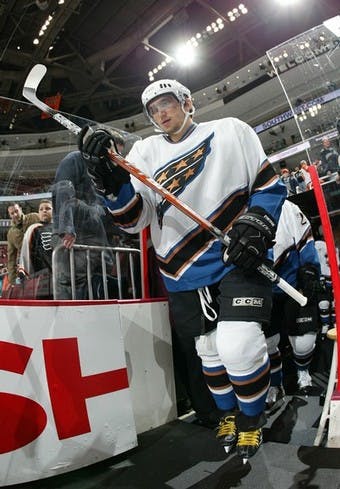The Bounces

Alexander Ovechkin is probably the most popular player with the fans in the National Hockey League. He’s certainly it’s most electrifying figure — for all of the league’s efforts to put forward Sidney Crosby as the face of the game it is Ovechkin, a flashier, more physically imposing player with some genuine charisma who has claimed that role. He’s a player who most everyone who follows the league has seen play at least once, and a player that we’re all familiar with. Hence, he’s a perfect example for the point I’m going to make a little further down.
Greg Wyshynski (of Yahoo’s Puck Daddy blog) is one of the best in the business – and his influence is such that The Hockey News included him in their annual 100 People of Power and Influence in Hockey list. J.P. of Jaspers Rink is one of the most prominent Capitals bloggers out there and a sane observer of the game. Both feel that Ovechkin is in a slump right now. Here’s the quote featured in both articles:
But do you want to know what is bad? Over that 12-game span mentioned above, AO has a minus-8 rating (including back-to-back minus-2’s in his last two games), and hasn’t had a plus rating in a single game. Not one. And his five even strength points are just two more than Shaone Morrisonn has over that same stretch.
Alex Ovechkin, it seems, is bored. Bored enough to take shifts off. Bored enough to not backcheck on every play as if the season depended on it… which may be fine, because the season doesn’t depend on it. Yet.
Soon enough, though, one bad shift might be the difference between advancing a round in the playoffs and going home disappointed. Again. But for now, a subpar effort isn’t terribly costly, and so they happen.
I’m fairly sure that the picture isn’t nearly as bleak as J.P. paints it. For starters, conventional plus-minus rather stupidly includes short-handed goals against, which means that of Ovechkin’s -8 rating, three of those minuses didn’t come at even-strength but rather came as shorthanded goals against. The effect of the inclusion of short-handed goals in plus/minus is to punish offensive players and reward penalty-killers – and it unfairly makes some good offensive players seem worse defensively and some good defensive players seem better because they kill penalties.
In any case, I reviewed those three short-handed goals. The first was by Todd White of Atlanta. The puck was cleared by the Thrashers defnder, and Washington’s two pointmen (Ovechkin and Mike Green) raced back to their zone with Ilya Kovalchuk of Atlanta chasing the puck. Green overskated Kovalchuk, so Ovechkin veered in to help recover the puck. Kovalchuk passed it by Ovechkin over to Todd White, who had outraced three Washington forwards back to the Capitals zone and was alone in the slot, and White scored. You might question Ovechkin’s defensive awareness, but given that Alexander Semin was ahead of every Thrasher when the puck was cleared, he has every reason to expect that the first player back would be his teammate.
Matt Cullen scored the second short-handed goal against, on a two-on-two play where Sergei Fedorov back-checked hard to take out his man and Cullen stepped by Mike Green and scored. Ovechkin had been playing the left point and had tried to keep the puck in, which caused the two-on-two break, but with two guys in good position to get back, isn’t it the right decision to try and hold the puck in on the powerplay?
The third goal was scored by Patrick Eaves. Here, Ovechkin was covering the slot, and Eaves went around to the far left of the net blowing by Niklas Backstrom and scoring from a tough angle. The fault for this goal against rests, not on Ovechkin, but on Backstrom who was badly outplayed by Eaves.
That still leaves Ovechkin as -5 at even-strength over those twelve games. Eight goals were scored for with Ovechkin on the ice and thirteen were scored against. However, a quick look at Vic Ferrari’s Time On Ice tool, which strips information of NHL play-by-play sheets, gives us a more complete view. Here are the numbers:
- Goals For/Against: 8/13 (-5)
- Shots For/Against: 121/107 (+14)
- Missed Shots For/Against: 72/34 (+38)
- Blocked Shots For/Against: 69/47 (+22)
- Shot Attempts For/Against: 262/188 (+74)
In other words, despite being outscored 13-8 with Ovechkin on the ice at even-strength, Washington had fired 74 more shots at their opposition’s net than they allowed. A bunch of those shots missed the net and others were blocked, which helps make the shots for and against closer to even, with Washington only outshooting the opposition 121 to 107. None of that has anything to do with being bored or lazy backchecking – it’s just that more of Washington’s shots were blocked or missed than the opposition’s.
As for the rest of the discrepancy, take a quick look at the save percentage of Washington’s goalies and the opposition’s goalies while Ovechkin was on the ice during that span:
- Washington: .879 SV%
- Opposition: .931 SV%
Maybe Ovechkin isn’t backchecking like he should. For all I know, he is bored. But those things almost certainly aren’t connected to why Alexander Ovechkin has a -8 rating over his past 12 games. Some of it is related to the stupidity of the statistic (which includes not only short-handed goals but also empty-netters), but the rest of it is because Washington’s shots were missing the net, getting blocked, or just plain getting saved at a much higher rate than that of the opposition.
Recent articles from Jonathan Willis




